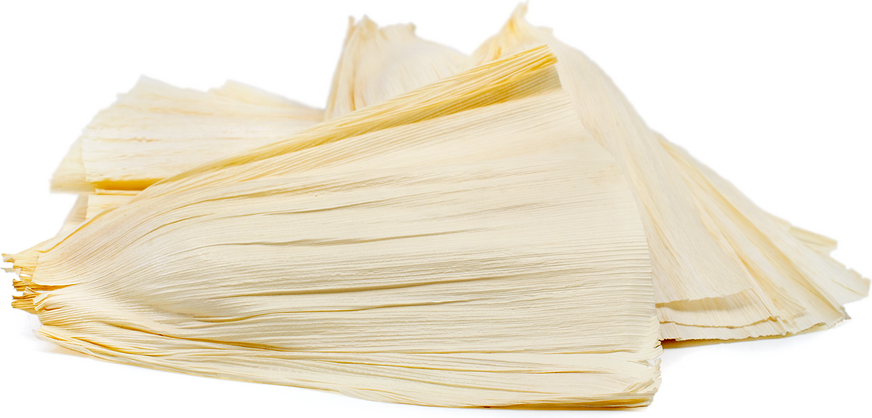


Corn Husk
Estimated Inventory, 24 ct : 1.62
This item was last sold on : 08/01/25
Description/Taste
Corn husks are the outer covering that ears of corn are wrapped in. When still intact around the corn, they are light green with a soft yet starchy texture and are tightly stacked in many layers over the ears of corn. Once they are removed from the corn and start to dry, their color fades to a beige-yellow hue and they become stiffer. When laid flat, these Corn husks measure about 23 to 25 centimeters long and 18 to 23 centimeters wide but may vary depending on the corn variety. They have a ribbed, papyrus-like texture that’s slightly crinkled with veins running along their length. Corn husks have a grassy scent and taste, with a flavor that's subtly reminiscent of the vegetables they encase. While they are not typically consumed, Corn husks can infuse their flavors into the foods with which they are cooked.
Seasons/Availability
Corn husks are available year-round.
Current Facts
Corn husks are botanically classified as Zea mays, the same as all varieties of corn, and belong to the Poaceae family along with bamboo, barley, foxtail, millet, rye, and wild rice. Corn husk is the term used for the leaf tissue that encases ears of corn. It protects the corn from being harmed or dehydrated while its kernels are growing. Husks have a variety of functional uses. Their paper-like texture led farmers to use them for writing. Corn husks have also become an integral part of Mexican cuisine, often serving more as a decorative element than as a commonly consumed food. Neconchada is a style of Corn husk for making tamales, one of the most common ways they are used in Mexican food.
Nutritional Value
While they are not traditionally consumed, Corn husks contain dietary fiber. This nutrient encourages proper cholesterol levels and digestive health. Corn husks are also rich in ferulic acid, a powerful antioxidant that helps protect cells from oxidative damage, contributing to anti-aging and anti-inflammatory benefits. Corn husks contain a moderate amount of protein, an essential part of tissue repair, muscle development, immune health, hormone and enzyme production, and nutrient transportation. Untreated Corn husks should not be eaten directly, as their insoluble fiber can cause gastrointestinal discomfort. Corn husks are typically used in secondary processing, where their beneficial components, such as fiber and ferulic acid, are extracted or used in small quantities to add nutritional benefits to food without the negative side effects.
Applications
Corn husks are not typically considered an appetizing or recommended food to consume on their own but are often cooked and served alongside other ingredients, particularly in traditional Mexican cuisine. They are commonly sold in packs of whole husks that are sun, air, or oven-dried. Various meats, vegetable fillings, cheese, and other savory mixtures can be baked or steamed in Corn husk-wrapped tamales. These husks may be added to stocks for mushroom soups, corn chowders, or chicken tortilla soups to impart a woody, corn-like flavor. They can also serve as a wrap for seafood or sticky rice. Corn husks used in the presentation of a dish should be discarded before the food is consumed. To prepare, soak them in warm water until they are pliable. Then remove any remaining silk strands and wash the husks thoroughly. Cover them with warm water and let stand for two hours or until they are soft. Corn husks should be stored in a cool, dry place.
Ethnic/Cultural Info
Many Native American children enjoyed turning Corn husks into dolls. They crafted these dolls by removing the husks from corn, drying them, and cutting parts of the husk into strips. These strips were wrapped around larger portions of the husks to create different body parts and garments for these dolls, like dresses, sleeves, faces, and hair. The kids of Early American settlers from Europe caught onto this practice and started making the dolls themselves. This was then picked up by pioneer children who would bring their dolls with them on their westward travels to California. Corn husk dolls remained a popular toy and craft into the 19th century.
Geography/History
Corn husks are native to Central Mexico and have been sown there for approximately 7,000 years. They grow in warm climates with full sun exposure and well-drained soils. Husked corn is a domesticated descendant of a wild grass called teosinte and is primarily grown in commercial and home garden settings. The corn crop spread from its native region northward to the Southwestern United States and south along the coast to Peru. When Native Americans moved to the eastern woodlands of present-day North America, they also brought Corn husks with them. Corn husks have become a popular item in Northern Mexican and Southwestern United States cuisine, especially for wrapping around foods like tamales. In these regions, husks can be purchased from specialty stores, grocers, and farmers' markets, particularly those that focus on Hispanic foods.
Featured Restaurants
Restaurants currently purchasing this product as an ingredient for their menu.
| Coasterra | San Diego CA | 619-814-1300 |
| Miguel's 4S Ranch | San Diego CA | 858-924-9200 |
| Snake Oil Cocktail Company LLC | San Diego CA | 619-754-4041 |
| Ridgeview Health Center | San Diego CA | 858-293-3950 |
| Communion | San Diego CA | 619-606-5568 |
Recipe Ideas
Recipes that include Corn Husk. One




